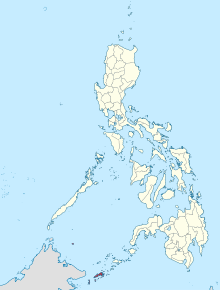| Sulu bleeding-heart | |
|---|---|

| |
| Scientific classification | |
| Domain: | Eukaryota |
| Kingdom: | Animalia |
| Phylum: | Chordata |
| Class: | Aves |
| Order: | Columbiformes |
| Family: | Columbidae |
| Genus: | Gallicolumba |
| Species: | G. menagei
|
| Binomial name | |
| Gallicolumba menagei | |

| |
| Map of the Philippines highlighting Tawi-tawi | |
| Synonyms | |
The Sulu bleeding-heart or Tawitawi bleeding-heart (Gallicolumba menagei) is a species of bird in the pigeon and dove family, Columbidae. It is endemic to the island of Tawi-Tawi and its surrounding islets in the Philippines' Sulu Archipelago. This species is known only from two specimens collected in 1891, and has not been recorded with certainty since. It lives in primary and secondary forests that have a closed canopy. The Sulu bleeding-heart is a medium-sized pigeon with a short tail. Bright metallic green feathers stretch from the forehead and crown down to the mantle and sides of the breast, where they surround a large, pale orange breast spot with diffuse edges that gives the species the name "bleeding-heart". The lower wings and back are varying shades of brown, and the throat and chest are largely white. The belly is an ashy-gray.
Like other bleeding-hearts, the Sulu bleeding-heart is primarily a sedentary bird, feeding on the forest floor and flying only for short distances. Little is known about its behavior due to the paucity of sightings. Searches of Tawi-Tawi in 1971 and 1991 did not discover any evidence of the species' continued existence. Most of the bird's habitat was logged on Tawi-Tawi by 1994. However, an ethnobiological survey in 1995 revealed that the bleeding-heart was common until the 1970s and still survives on small islets near Tawi-Tawi. While another survey in 2009 failed to find the species, there is some hope that it may still persist. For this reason, it is currently listed as critically endangered by the IUCN. Any surviving population would be very small, likely numbering fewer than 50 individuals, and would be threatened by habitat destruction and uncontrolled hunting.
- ^ BirdLife International (2016). "Gallicolumba menagei". IUCN Red List of Threatened Species. 2016: e.T22691005A93299100. doi:10.2305/IUCN.UK.2016-3.RLTS.T22691005A93299100.en. Retrieved 11 November 2021.
